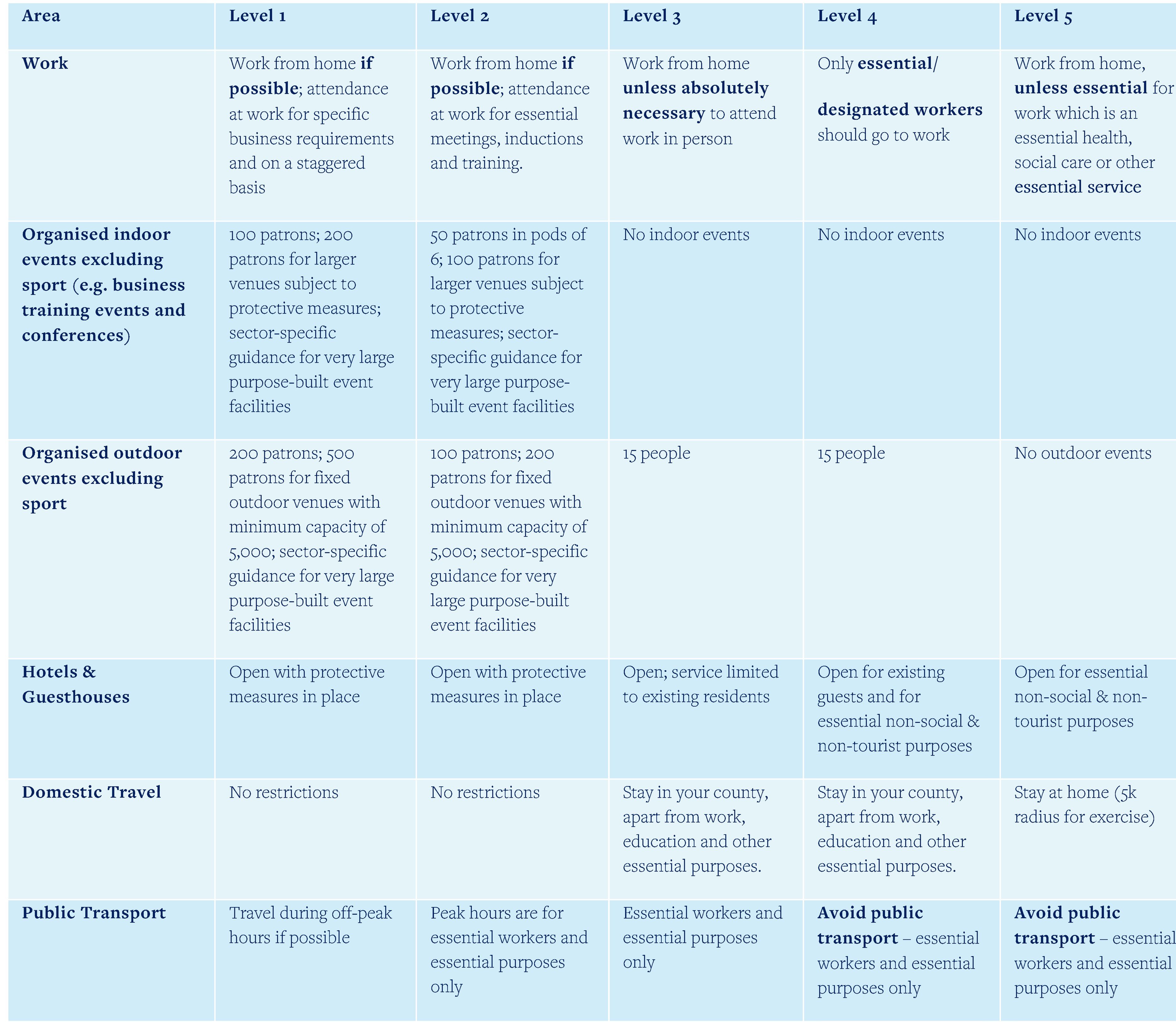COVID-19: Recovery Plan - What Employers Need to Know
In June, following a prolonged lockdown, the Government has published its Roadmap for Reopening Business and Society. Back then, things looked quite optimistic. The plan consisted of 5 distinct phases, each phase easing the restrictions in place, allowing businesses to slowly re-open and workers to return to their workplace. However, in reality, the plan never progressed beyond its third phase. In August, the Government introduced new temporary restrictions and the plan was, effectively, abandoned. A new plan was rumoured to be in the works. This new – and long anticipated - COVID-19 recovery plan was finally published by the Government last week.
The new plan (the “Plan”) establishes The Framework for Restrictive Measures (the “Framework”), which is described as a risk management strategy for the next 6-9 months. “It is designed to allow individuals, families, businesses and services better understand, anticipate and prepare for the measures Government might introduce to stop escalation of the transmission of the disease.” The Framework is designed to account for periods of low incidence of Covid-19 as well as periods of high or rapidly increasing incidence. It is said to recognise “the need for society and business to be allowed to continue as normally as possible”. It is designed in a way so that either national or county-level restrictions can be applied. The overall strategy is said to be, in line with public health advice, suppression.
The Plan consists of 5 different levels, every level having its accompanying set of restrictions. In this briefing, we will provide a quick general overview of the Plan and the restrictions involved in each level insofar as they relate to measures which employers should pay particular attention to.
1. The Levels
The Plan expressly recognises the need to keep people at work and business operating during this pandemic. Therefore, the Framework “reflects a careful consideration of the impact of the introduction of restrictions on employment and livelihoods keeping as many businesses open as possible at different stages, while acknowledging that some business and services are critical”. Below you will find a table with an abridged version of the applicable restrictions at each level of the Plan with particular focus on measures relevant to employers and employees. For a full list of the applicable restrictions, see the Government’s plan here.1

2. How will the Plan be implemented and monitored?
The Plan establishes a framework for the Government to implement policy responses to the pandemic over the course of the next 6-9 months. The COVID-19 Oversight Group (consisting of various Government Departments, the Chief Medical Officer and Chief Executive of the HSE, and chaired by the Secretary to the Government) is the body responsible for overseeing and directly implementing the Government’s policy responses. The Group will be meeting weekly to provide advice to the Government and consider advice by the National Public Health Emergency Team (based on NPHET’s monitoring of the risk level associated with COVID-19). At the same time, the Cabinet Committee on COVID-19 (which is chaired by the Taoiseach) will continue to assess the social and economic impacts of the potential spread of COVID-19 and oversee the cross-Government response. Finally, the Department of the Taoiseach will also convene senior officials’ groupings and sub-groups to drive the implementation of the Plan and support preparations for the Cabinet Committee and the Oversight Group. The Roadmap is due to be fully reviewed at the end of March 2021.
This Framework is designed in such a way that it allows either national or county-specific restrictions to be applied. As of the date of this briefing, Ireland is at Level 2 of the Plan, albeit more stringent restrictions apply in Dublin and Donegal both of which are at Level 3 of the Plan. The current status in Ireland can be checked on the Government’s webpage here, which is updated regularly. The imposition or lifting of restrictions in line with the Framework is to be considered by the Cabinet Committee on an ongoing basis, with a three-week interval for the consideration of the impact of any restriction changes.
3. What other measures must employers be aware of to ensure compliance with the Plan?
The Return to Work Safely Protocol
The Return to Work Safely Protocol continues to be the main guiding tool for employers. We have recently written on the Protocol in our briefing here. Other sector-specific guidelines may also be developed in line with the Protocol (and indeed, some of these sector-specific guidelines have already been published, such as the Guidance for Further and Higher Education for returning to on-site activity in 2020 collated by the Department of Further and Higher Education, Research, Innovation and Science). According to the Plan, the Protocol is due to be updated and a new and renamed “Return to Work Safely Protocol” will be published by the HSA to reflect any changes in public health guidance. The Plan also makes it clear that all sectoral guidance will be updated to reflect the new Framework.
Other support tools available to employers
The Plan also encourages employers to utilise the various templates and checklists prepared by the HSA in order to assist employers, business owners and managers with putting in place measures that will prevent the spread of COVID-19 in the workplace and ensure compliance with the Protocol. These can be accessed on the HSA's website here. The Plan also makes reference to the Practical Workplace Protection and Improvement Guidance available to businesses on how to manage business continuity during the COVID-19 pandemic; this guidance can be accessed on the NSAI’s webpage here.
High-Risk areas
The Government has already designated certain workplaces and settings as high-risk areas where COVID-19 spreads most easily (e.g. the food industry, and in particular: food plants). The Plan identifies the factors that contribute to these high-risk settings and employers should keep these in mind when developing Covid-19 response plans and policies in their organisations. These factors include, for example:
- inconsistency of workplace practices in the application of guidance;
- use of shared transport by some workers;
- economic disincentives for workers who present for testing, are required to restrict movements or test positive; and
- specific requirements for personal protective equipment or specialist infection control supports – particularly in the workplace setting.
How will compliance with the Plan at the workplace be enforced?
Originally, when the Return to Work Safely Protocol was first published, compliance was monitored by the HSA using their existing powers under the Safety, Health and Welfare at Work Acts, which include inspection powers and the power to issue Improvement Notices and Prohibition Notices requiring the cessation of work activities in cases of serious non-compliance. Since then, the inspectorate of the Health and Safety Authority has been supplemented by inspections from the Workplace Relations Commission, the Department of Agriculture and Food and Environment and Health Officers of the Health Services Executive. The Plan also states that other inspectorate bodies are in the process of agreeing memoranda of understanding with the HSA to carry out Protocol compliance checks. Further, the Plan promises that existing legislative provisions dealing with COVID-19 measures will be reviewed and consolidated, and any enhancements required to support compliance and enforcement will be considered.
How can we help?
Our Employment, Pensions and Incentives Group would be happy to address any questions employers may have in relation to the new Covid-19 Recovery Plan or the Return to Work Safely Protocol. Your usual contact in McCann FitzGerald would be happy to provide further information.
Also contributed by Ivan Gendelman
- Not included in the table are measures relating to, inter alia: social/family gatherings, sports and sporting activities, religious services, hospitality, retail & personal services, schools & education, and measures for over 70s.
This document has been prepared by McCann FitzGerald LLP for general guidance only and should not be regarded as a substitute for professional advice. Such advice should always be taken before acting on any of the matters discussed.



Select how you would like to share using the options below